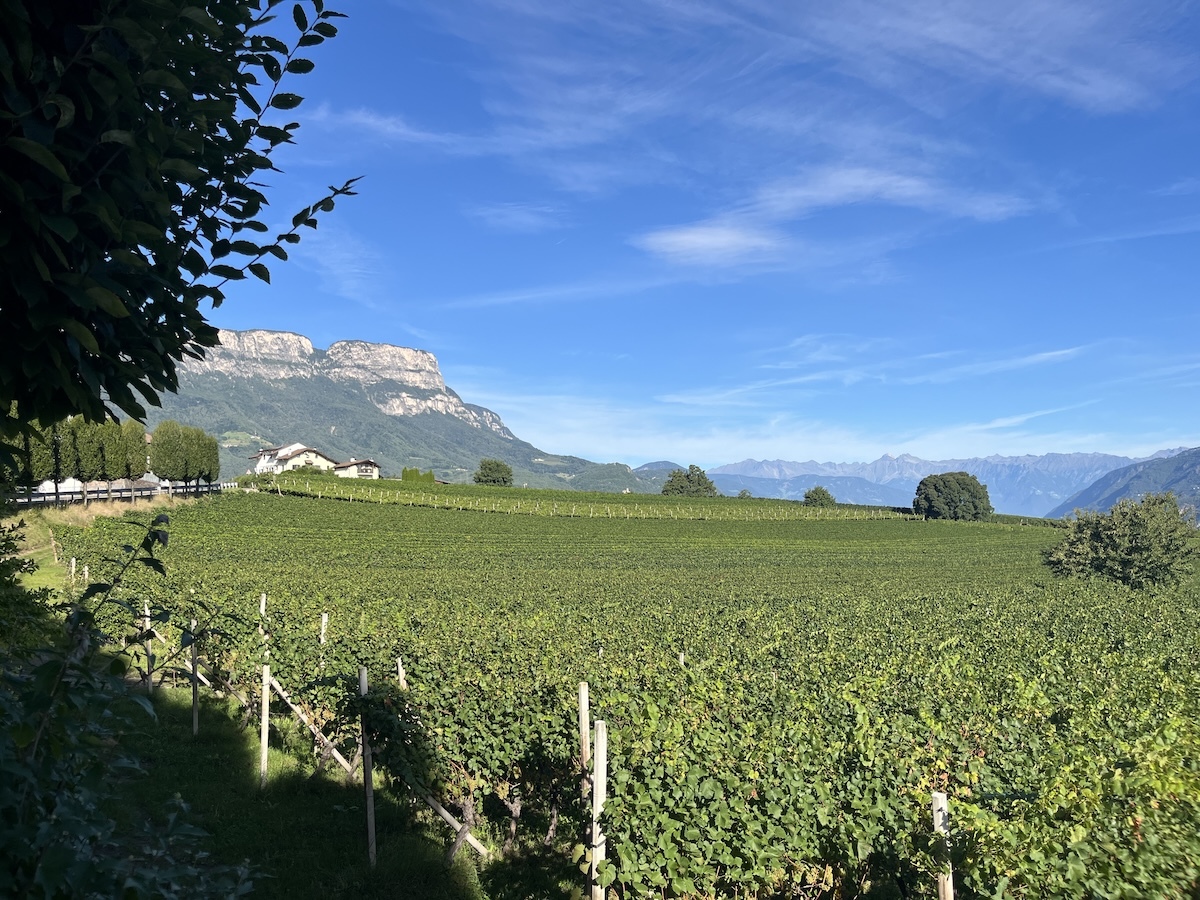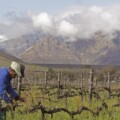A little after nine in the morning, Harald Cronst met us in the parking lot of the Kellerei Kurtascht winery and told us to get back in the van. Driving ahead, he led us up a single lane switchback of a road through the village the winery is named after, quickly ascending from 300 metres above sea level to over 800. At the end of the road, we hiked past a small church and graveyard to find a steep hill planted with grape vines and a spectacular view.
We looked over the patchwork of green vineyards and apple orchards in the Adige River Valley below us and the grey, ragged peaks of the Dolomite Alps above us to the north and east. Cronst handed out glasses, and we tasted wine made from the vines we stood in. The 2024 “Graun” Muller-Thurgau was fresh and florally aromatic before settling into peach notes; it was crisp and fresh and woke up my palate dulled by coffee.
We were closer to breakfast than lunch, so when we had spat out a few mouthfuls of the Graun, we moved onto what Cronst called Kurtascht’s “mountain wine.” The 2023 Amos was a blend of the Alto Adige wine region’s greatest hits of white wine grapes. It is mostly made up of fruit-forward Pinot Bianco (or Weissburgunder, or Pinot Blanc), Chardonnay, and Pinot Grigio (or Grauburgunder, or Pinot Gris). But a small amount of Sauvignon Blanc and Riesling gave it a lift, and confounded any hope that I’d have guessed what was in it if Cronst hadn’t told us. It was just good.
From the perspective of the Graun vineyard, the Dolomite Alps look like a barrier and the walls of a great rock and snow-topped fortress. But they have, in fact, always been the opposite. The mountain passes of the Dolomites are connectors, linking Northern and Southern Europe. All manner of people, goods, and ideas move through them, and some of them stay.
Alto Adige (“the Upper Adige”) is also called Südtirol (the “South Tyrol”). It was part of the Habsburg Austro-Hungarian Empire before being assumed into the Kingdom of Italy under the terms of the Treaty of Versailles following the First World War. Mussolini tried to Italianize the region and made an agreement with Hitler to voluntarily resettle its German-speaking population in the Third Reich. Most chose to stay.
It took until the 1970s for German-speaking South Tyroleans to establish protective rights from the Italian Republic, but by then the region was already flourishing and projecting a Teutonic Alpine character that includes a pronounced Italo-Mediterranean flavour. Andi Punteer, the sales and marketing director for Franz Haas Winery, told me he is glad to make his life in Alto Adige because he believes he enjoys the best of both worlds.
Punter told me this over a glass of the 2023 Franz Haas Pinot Nero, which itself embodied a best of both worlds spirit. Racy red fruit mixed with darker notes in this wine made from high altitude vines on steep slopes. The elevation makes for cool nights, but the southern latitude and high grade of the hillsides mean maximum exposure to sunshine, so the grapes are perfectly ripe while retaining refreshing acidity.
This meeting of Alpine and Mediterranean Europe ran like a mountain stream through just about all the 200 or so wines I tasted over four days in the Dolomites. I was there as a guest of the Südtirol Wein/Vini Alto Adige/Alto Adige Wines consortium. My tours and tastings culminated in the Alto Adige Wine Summit and provided a comprehensive experience of the wines that are in the market now or coming shortly.
What I found on the ground, and at the show, was a small region with a high standard for quality. There were a few wines I tasted that I didn’t love for reasons of style, but there were no wines that could be said to have been poorly made. I have always liked the wines of Alto Adige that I have tasted in Canada, but after an extensive exposure there from as many producers as I could manage, I was surprised to find no bad wines.
When I began to be interested in Alto Adige wines, a bit more than a decade ago, I noticed that many, maybe even most, of the labels that caught my interest were made by co-operatives. At Cantina Girlan, marketing manager Marc Pfitscher explained that this wasn’t a coincidence. Nearly three-quarters of the region’s wine producers are co-operatives, typically named after the village in which they are housed.
At some point during Habsburg rule, inheritance laws in the Südtirol banned primogeniture and divided estates equally among the children of the dead. The result, like that in Burgundy, was the distribution of land into small holdings. When commercial wine production came to Alto Adige at the end of the 19th century, the region’s independently minded grape growers organized themselves into co-operatives.
Pfitscher explained that the cooperative at Girlan buys grapes from 200 members, most of whom farm the plots that surround the village. The fate of the co-operative is essentially the fate of the town. There are monetary incentives to encourage the highest quality and standards of viticulture from the members, but the greatest incentive to make the best and most marketable wine is enlightened self-interest.
At Weingut Tieffenbrunner, Christoff Tiefenbrunner embodies the estate-owned exception to Alto Adige’s cooperative rule. His family has owned the castle and vineyards there for 350 years. For all that history, the Tiefenbrunners have not been afraid to innovate. In the late ‘80s and ‘90s, Tieffenbrunner planted Chardonnay and Cabernet Sauvignon, which do well on the steep eastward-facing slopes.
Tiefenbrunner hosted my van group of Canadian wine writers for lunch on the day that started at the high altitude Graun vineyard, and invited Punter from the Franz Haas estate and Cronst from Kuratsch and Gottfried Pollinger from another co-operative (this time named after two villages), Nals Magreid. After a tasting of a dozen or so wines, we settled at a long table between the walls of the castle and its renowned garden, looking over the valley on one side, and up the vineyard hillsides on the other.
Lunch was a giant tray of local cheeses and cured meats, including (of course) speck, the Südtirol specialty that’s a kind of cross between prosciutto and smoked ham. Next to the board were great plates of just-picked tomatoes in local olive oil. And we toasted our good fortune to be enjoying the best of both worlds.










